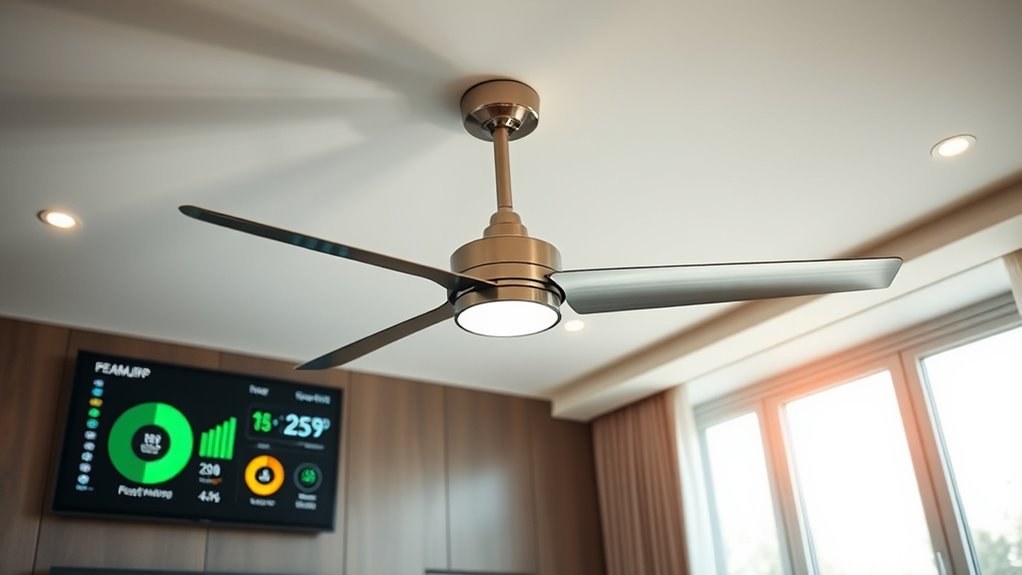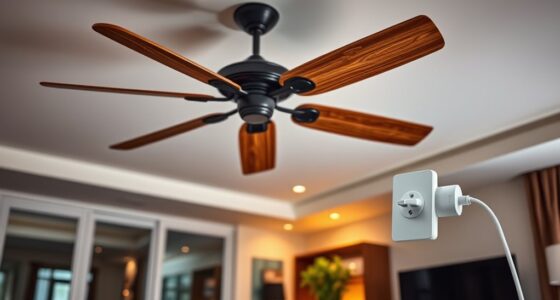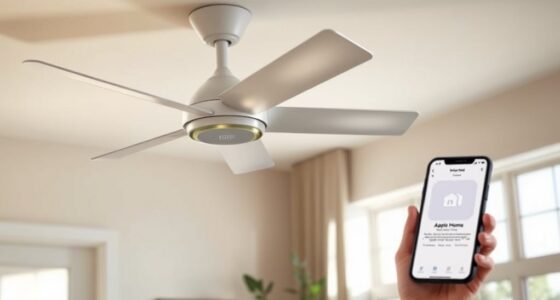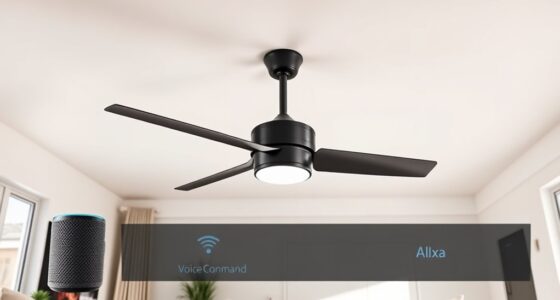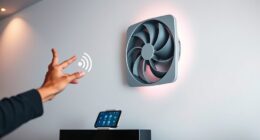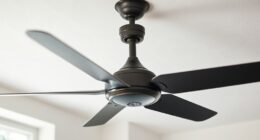Integrating smart ceiling fans with energy management systems enhances efficiency by providing real-time environmental monitoring, adaptive control, and automation. You can use sensors to measure temperature, humidity, and occupancy, enabling the system to dynamically adjust fan operation. This integration optimizes airflow, reduces unnecessary energy use, and allows scheduled control for different conditions. Advanced data analytics also support maintenance and performance improvements. Exploring these features further reveals how such systems can deliver smarter, energy-efficient solutions tailored to your needs.
Key Takeaways
- Enables real-time environmental monitoring for precise fan control and energy efficiency.
- Facilitates adaptive control strategies responding dynamically to occupancy and weather data.
- Supports automation scheduling for optimized operation during different times and conditions.
- Ensures secure data exchange through encryption and user authentication within integrated systems.
- Provides detailed energy usage reports to identify inefficiencies and improve overall system performance.

Smart ceiling fans equipped with energy management systems represent a significant advancement in HVAC efficiency by integrating real-time monitoring, adaptive control, and automation features. This integration enables precise regulation of airflow and temperature, aligning fan operation with actual environmental conditions and occupancy patterns. When you connect a smart ceiling fan to an energy management system, you gain access to a networked platform that collects data from sensors embedded in the fan and the surrounding environment. These sensors measure parameters such as room temperature, humidity, and occupancy status, providing continuous feedback that informs control algorithms. As a result, the system can automatically adjust fan speed, oscillation, and operation schedules to optimize comfort while minimizing energy consumption.
Smart ceiling fans with energy management systems optimize comfort and reduce energy use through real-time monitoring and adaptive control.
The core benefit of this integration lies in the system’s ability to implement adaptive control strategies. Unlike traditional fans that operate on fixed timers or manual switches, a smart fan dynamically responds to real-time data, reducing unnecessary energy expenditure. For instance, if sensors detect that a room is unoccupied, the system can power down or reduce fan speed, preventing wasteful operation. Conversely, it can increase airflow ahead of occupancy detection, ensuring comfort is maintained proactively. This proactive approach not only conserves energy but also enhances user comfort, as the system fine-tunes performance based on environmental cues rather than static settings.
Automation features further enhance efficiency by enabling scheduling and scene-based controls. You can program the system to operate at specific times or conditions, such as lowering fan speeds overnight or adjusting airflow during peak heat hours. Advanced integration allows these schedules to be dynamically modified based on occupancy or weather forecasts, making control more responsive and context-aware. Additionally, energy management systems often interface with building automation platforms, allowing centralized control across multiple zones. This holistic approach ensures that HVAC systems work synergistically, reducing overall energy consumption across the entire building.
Security and data privacy are critical considerations in integrating smart ceiling fans with energy management systems. These platforms typically employ encryption protocols and user authentication to safeguard sensitive data. Furthermore, the analytical capabilities of these systems facilitate detailed energy usage reporting, enabling you to identify inefficiencies and optimize operations over time. You can leverage this data to inform maintenance schedules, identify faulty sensors, or evaluate the impact of control strategies, further improving system performance.
Frequently Asked Questions
Can Smart Ceiling Fans Be Integrated With Existing Home Automation Systems?
Yes, smart ceiling fans can be integrated with existing home automation systems. You’ll need compatible devices, such as fans with Wi-Fi or Zigbee modules, and a hub or controller that supports your automation platform. By configuring the system’s API or using dedicated apps, you can automate fan operation based on schedules, temperature, or occupancy. This integration enhances energy efficiency and provides seamless control through your existing smart home ecosystem.
What Are the Typical Costs of Installing Smart Ceiling Fans With Energy Management?
The costs of installing smart ceiling fans with energy management typically range from $150 to $300 per unit, covering the fan, smart controls, and integration setup. Additional expenses may include professional installation and system calibration, which can add $50 to $150. While initial investments seem notable, the energy savings and enhanced control often justify the expenditure over time, making this an efficient upgrade for your home’s automation ecosystem.
How Secure Are Smart Ceiling Fans From Hacking or Unauthorized Access?
Smart ceiling fans employ encryption protocols like WPA2 and WPA3, making unauthorized access difficult. However, vulnerabilities exist if default passwords aren’t changed or firmware isn’t updated regularly. You should guarantee your Wi-Fi network has strong security measures, enable two-factor authentication where possible, and keep firmware current. Regularly monitoring network activity also helps identify suspicious access attempts, reducing hacking risks and maintaining system integrity.
Do Smart Ceiling Fans Require Professional Installation or Can They Be DIY?
You can install smart ceiling fans yourself, provided you have basic electrical skills and follow manufacturer instructions. Many models include detailed guides or video tutorials, making DIY setup feasible. However, if your wiring is complex or local codes require, hiring a professional ensures safety and correct installation. Think of it as assembling a vintage radio—precision matters. For maximum performance and security, professional installation is recommended when in doubt.
How Do Smart Ceiling Fans Adapt to Different Climate Zones?
Smart ceiling fans adapt to different climate zones primarily through customizable settings and adaptive algorithms. You can program them for ideal airflow, humidity control, and temperature regulation based on your specific environment. They utilize sensors to detect changes in ambient conditions, automatically adjusting fan speed and operation to maximize comfort and energy efficiency. This intelligent adaptation ensures effective climate management regardless of regional variations, enhancing overall system performance and user comfort.
Conclusion
Integrating smart ceiling fans with energy management systems transforms your space into a symphony of efficiency, where technology orchestrates the most favorable comfort and conservation. By leveraging real-time data and automation, you can reduce energy consumption while maintaining ideal conditions. This seamless synergy not only enhances operational performance but also positions you at the forefront of sustainable innovation. Embrace this integration—it’s the keystone to unblocking smarter, more efficient environments that are both intelligent and environmentally responsible.
